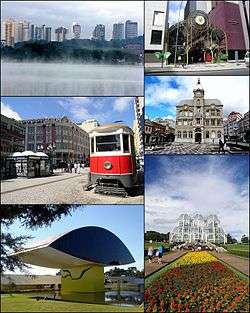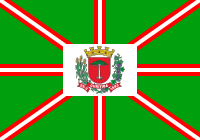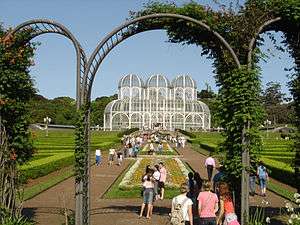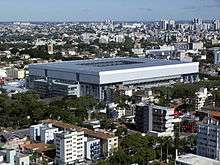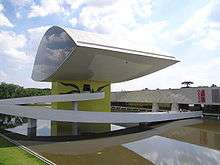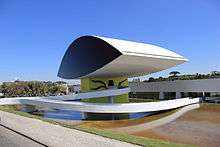Curitiba
| Curitiba | |||
|---|---|---|---|
| Municipality | |||
| Município de Curitiba Municipality of Curitiba | |||
|
Clockwise from Top: Skyline from Barigui Park; 24 Hours Street; Paço da Liberdade; The Botanical Garden of Curitiba, Oscar Niemeyer Museum; Palace Avenue building. | |||
| |||
| Nickname(s): Cidade Modelo ("Model City"); Capital Ecológica do Brasil ("Ecological Capital of Brazil"); Cidade Verde ("Green City"); Capital das Araucárias ("Capital of Araucarias"); A Cidade da Névoa Eterna ("The City of Eternal Fog") | |||
| Motto: A Cidade da Gente (Our City; The People's City) | |||
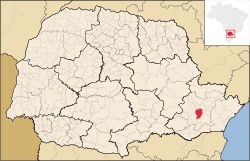 | |||
 Curitiba Location in Brazil | |||
| Coordinates: 25°25′S 49°15′W / 25.417°S 49.250°WCoordinates: 25°25′S 49°15′W / 25.417°S 49.250°W | |||
| Country |
| ||
| Region | South | ||
| State |
| ||
| Founded | 29 March 1693 (323 years) | ||
| Incorporated | 1842 | ||
| Government | |||
| • Mayor | Gustavo Fruet (PDT) | ||
| Area | |||
| • Municipality | 430.9 km2 (166.4 sq mi) | ||
| • Urban | 319.4 km2 (123.3 sq mi) | ||
| • Metro | 15,416.9 km2 (5,952 sq mi) | ||
| Elevation | 934.6 m (3,066.3 ft) | ||
| Population (2015) | |||
| • Municipality | 1,879,355[1] (8th) | ||
| • Density | 4,062/km2 (10,523/sq mi) | ||
| • Metro | 3,400,000 (7th) | ||
| • Metro density | 210.9/km2 (546.2/sq mi) | ||
| Time zone | UTC-3 (UTC-3) | ||
| • Summer (DST) | UTC-2 (UTC-2) | ||
| CEP | 80000-000 to 82999-999 | ||
| Area code(s) | +55 41 | ||
| Website | Curitiba, Paraná | ||
Curitiba (Tupi: "Pine Nut Land", Portuguese pronunciation: [kuɾiˈtʃibɐ]) is the capital and largest city of the Brazilian state of Paraná. The city's population numbered approximately 1,879,355 people as of 2015, making it the eighth most populous city in the country, and the largest in Brazil's South Region. The Curitiba Metropolitan area comprises 26 municipalities[2] with a total population of over 3.2 million (IBGE estimate in 2010),[3] making it the seventh most populous in the country.
Curitiba is an important cultural, political, and economic centre in Latin America.[4] The city sits on a plateau at 932 metres (3,058 ft) above sea level. It is located 105 kilometres (65 mi) west of the seaport of Paranaguá and is served by the Afonso Pena International and Bacacheri airports. The city hosts the Federal University of Paraná, established in 1912.
In the 1700s Curitiba possessed a favorable location between cattle-breeding country and marketplaces, leading to a successful cattle trade and the city's first major expansion. Later, between 1850 and 1950, it grew due to logging and agricultural expansion in the Paraná State (first Araucaria logging, later mate and coffee cultivation and in the 1970s wheat, corn and soybean cultivation). In the 1850s waves of European immigrants arrived in Curitiba, mainly Germans, Italians, Poles and Ukrainians, contributing to the city's economic and cultural development.[5] Nowadays, only smaller numbers of foreign immigrants arrive, primarily from Middle Eastern[6] and other South American countries.
The biggest expansion occurred after the 1960s, with innovative urban planning that changed the population size from some hundreds of thousands to more than a million people.[7] Curitiba's economy is based on industry and services and is the fourth largest in Brazil.[8] Economic growth occurred in parallel to a substantial inward flow of Brazilians from other cities of the country, as approximately half of the city's population was not born in Curitiba.[9]
Curitiba sports one of the few high Brazilian Human Development Index readings at 0.856, and in 2010 was awarded the Global Sustainable City Award, given to cities and municipalities that excel in sustainable urban development.[10] According to US magazine Reader's Digest, Curitiba is the best "Brazilian Big City" in which to live.[11][12] Curitiba crime rate is considered low by Brazilian standards and the city is considered one of the safest cities in Brazil for youth[13]
Curitiba was one of the host cities of the 1950 FIFA World Cup, and again for the 2014 FIFA World Cup.
Name
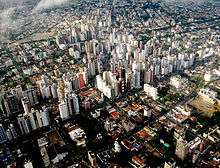
One theory is that the name "Curitiba" comes from the Tupi words kurí tyba, "many pine seeds" due to the large number of pinecones of Paraná pines in the region prior to its founding.[14] Another version, also using words from the Tupi language, is that it originates in the combination of kurit (pine tree) and yba (large amount).[15]
The Portuguese who founded a settlement on the site in 1693 named it "Vila da Nossa Senhora da Luz dos Pinhais" (Village of "Our Lady of the Light" of the Pines). The name was changed to "Curitiba" in 1721. Curitiba officially became a town in 1812, spelling its name as "Curityba." An alternative spelling was "Coritiba." This was used in press and state documents. A state decree in 1919 settled the dispute by adopting "Curitiba."[14]
Government
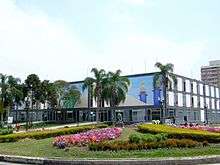
As of 2013 the mayor was Gustavo Fruet, who replaced Luciano Ducci. The City Council of Curitiba has 38 councillors elected since 2004. Curitiba is divided into nine regional governments (equivalent to subprefecture), who manage the municipality's 75 districts. The Rua da Cidadania ("Street of Citizenship") is the symbol of administrative decentralization; it is a reference point and a meeting place. Several units are annexed to public transport terminals. Their nuclei offer services in the local, state and federal areas.[16]
Jaime Lerner is perhaps Curitiba's best-known mayor. He has been mayor three times, the first time in the early 1970s. His leadership was crucial to some major changes in the city. Curitiba has built parks instead of canals to reduce flooding; used parks to make the city more liveable; pedestrianised the downtown area; invented and built Bus Rapid Transit (BRT), a bus system that works like a light rail system but is 10 times cheaper; and started a massive recycling scheme that included giving people bus tokens in return for waste.[17]
Time magazine listed this former mayor among the world's most influential thinkers of 2010. In the days before free, direct elections, mayors were political appointees who were no more than pawns in the game of power politics and were subject to replacement at any time. For an idealistic young architect like Lerner, retaining the mayor's office was particularly precarious. Those holding the reins of power at the time were under the mistaken impression that Lerner's youth would make him easy to control. As it turned out, he was no milquetoast, and subsequently set about enthusiastically pursuing reform.[18]
History
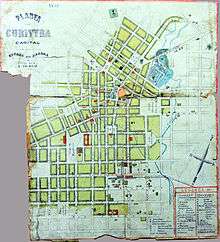
The first ten years of the 16th century had a war of conquest by Europeans (Portuguese colonists) against the Kaingang and Guarani who inhabited the area of the city. Curitiba's birth is 29 March 1693, when its City Council was founded. At the end of the 17th century, Curitiba's agriculture was only for subsistence. Its main economic activities were mineral extraction.[19] Waves of European immigrants arrived after 1850, mainly Poles, Italians, Germans (mostly from Russia) and Ukrainians.[5] In 1853, the south and southwest of the province of São Paulo were emancipated, forming the new province of Paraná with Curitiba as its capital.[20]
The region's next economic cycle was based on the "tropeiros" ("troopers"): cattlemen who drove their herds from Viamão, in the southernmost state of Rio Grande do Sul, to a market in Sorocaba, in the state of São Paulo. From there, the herds were then taken to the state of Minas Gerais. The drovers would spend winter periods in the middle of the journey, in the "campos de Curitiba" (fields of Curitiba). These campsites would be dismantled when the cold season gave way to spring. The drovers would take advantage of their stay to do business, and by doing so, they made Curitiba into an important intermediate trading post. The traditions of wearing wool ponchos, roasting meat and drinking a bitter mate tea called "chimarrão", encouraged a common culture that led people to form groups and settle.[19] The cycle of cattle drives lasted for more than two centuries. With it, came many distinct cultural features of the Paraná region, especially the unique accent noticeable by pronounced Es.[19]

The expanded use of the mate plant and wood at the end of the 19th century stimulated the construction of the Paranaguá-Curitiba railroad. This railroad was the first link between the capital of Paraná and the coast. It was built in five years (from 1880 to 1885). This railroad represents one of the greatest works of national engineering, made possible thanks to the engineers and brothers Antonio and André Rebouças. Immigrant manual labor was heavily used. Immigrants had come to this area since the middle of the 18th century.[19]
Around the beginning of the 20th century, Curitiba benefited from the wealth of the yerba mate mills. The owners (known as "Maté Barons") built mansions in the capital. These have mostly been preserved in the districts of Batel and Alto da Glória.
The next economic cycle was the coffee monoculture. This trade helped found cities in the northern region of the state of Paraná. Coffee was important the capital's economy.[19] Coffee crops suffered from the relentless effects of bad weather. So, farmers gradually replaced coffee by soybeans. Mechanized soybean farming drove agricultural workers off of the land. Eventually, coffee was completely wiped out in the region's worst frost, known as the Black Frost of July, 1975.
During the 20th century, especially after 1950, the city's population rapidly increased. It consolidated its position as a regional hub for trade and services, becoming one of the richest cities in the Southern Cone and a pioneer in urban solutions.[20] In the 1940s and 1950s, Alfred Agache, co-founder of the French Society for Urban Studies, was hired to produce its first city plan. It emphasized a "star" of boulevards, with public amenities downtown, an industrial district and sanitation. It was followed in part, but the plan was too expensive to complete.[21]
When Curitiba received great waves of immigrants, the city was forced to make swift decisions in order to avoid urban chaos and meet future demands. Curitiba invested in urban planning and in city management focused on its residents.
Geography
Climate
Curitiba has a subtropical highland climate (a form of oceanic or maritime temperate climate) (Cfb), according to the Köppen classification and the Brazilian government classification. Located in Southern Brazil, the humid city lies in a temperate zone.[22] It is located on a plateau and the flat terrain with flooded areas contribute to its mild and damp winter, with an average minimum temperature of 7 °C (45 °F) in the coldest month, occasionally falling below 0 °C (32 °F) on the coldest nights. During summertime, the average temperature is around 25 °C (77 °F) at daytime, but it can get above 30 °C (86 °F) on the hottest days. Snowfall was experienced in 1889, 1892, 1912, 1928 (two days), 1942, 1955, 1957, 1962, 1975 and again in 2013.[23][24] Its altitude makes it the coldest among Brazil's state capitals.
The terrain's flatness hinders water drainage after rain, therefore providing water vapor for the atmosphere. Cold fronts come year round, often from Antarctica and Argentina, bringing tropical storms in summer and cold winds in the winter. They can move very quickly, with no more than one day between the start of the southern winds and the start of rain.[25] Curitiba's weather is also influenced by the dry air masses that dominate Brazil's midwest most of the year, bringing hot and dry weather, sometimes even in winter.[26]
| Climate data for Curitiba (1961–1990) | |||||||||||||
|---|---|---|---|---|---|---|---|---|---|---|---|---|---|
| Month | Jan | Feb | Mar | Apr | May | Jun | Jul | Aug | Sep | Oct | Nov | Dec | Year |
| Record high °C (°F) | 34.1 (93.4) |
34.8 (94.6) |
33.5 (92.3) |
30.3 (86.5) |
28.3 (82.9) |
28.2 (82.8) |
27.8 (82) |
30.6 (87.1) |
32.8 (91) |
32.8 (91) |
34.0 (93.2) |
33.1 (91.6) |
34.8 (94.6) |
| Average high °C (°F) | 26.6 (79.9) |
26.7 (80.1) |
25.7 (78.3) |
23.1 (73.6) |
21.1 (70) |
19.6 (67.3) |
19.4 (66.9) |
20.9 (69.6) |
21.3 (70.3) |
22.6 (72.7) |
24.5 (76.1) |
25.4 (77.7) |
23.1 (73.6) |
| Daily mean °C (°F) | 20.4 (68.7) |
20.6 (69.1) |
19.6 (67.3) |
17.2 (63) |
14.5 (58.1) |
13.1 (55.6) |
12.9 (55.2) |
14.1 (57.4) |
15.0 (59) |
16.5 (61.7) |
18.2 (64.8) |
19.3 (66.7) |
16.8 (62.2) |
| Average low °C (°F) | 16.4 (61.5) |
16.3 (61.3) |
15.4 (59.7) |
12.8 (55) |
10.2 (50.4) |
8.4 (47.1) |
8.1 (46.6) |
9.2 (48.6) |
10.8 (51.4) |
12.5 (54.5) |
14.0 (57.2) |
15.4 (59.7) |
12.5 (54.5) |
| Record low °C (°F) | 8.2 (46.8) |
6.8 (44.2) |
3.9 (39) |
−4.0 (24.8) |
−2.3 (27.9) |
−4.0 (24.8) |
−5.2 (22.6) |
−5.2 (22.6) |
−5.4 (22.3) |
−1.5 (29.3) |
−0.9 (30.4) |
3.6 (38.5) |
−5.4 (22.3) |
| Average precipitation mm (inches) | 171.8 (6.764) |
157.6 (6.205) |
138.8 (5.465) |
94.8 (3.732) |
101.0 (3.976) |
115.6 (4.551) |
98.8 (3.89) |
73.4 (2.89) |
119.2 (4.693) |
133.3 (5.248) |
126.9 (4.996) |
152.3 (5.996) |
1,483.4 (58.402) |
| Average precipitation days (≥ 1.0 mm) | 15 | 12 | 12 | 8 | 7 | 7 | 6 | 7 | 9 | 10 | 10 | 13 | 116 |
| Average relative humidity (%) | 79.0 | 80.0 | 80.0 | 79.0 | 82.0 | 82.7 | 81.0 | 79.0 | 82.0 | 82.0 | 80.0 | 82.0 | 80.7 |
| Mean monthly sunshine hours | 184.4 | 160.8 | 172.0 | 164.2 | 178.3 | 160.2 | 173.4 | 175.4 | 134.1 | 155.5 | 177.0 | 170.9 | 2,006.2 |
| Source: INMET[27] | |||||||||||||
Vegetation
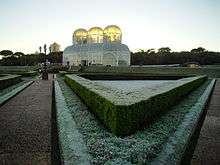
Curitiba is located in the area of the Ombrophilous Mixed Forest (also known as Araucaria moist forests), a sub-type of the Atlantic Forest. In Curitiba it is possible to find steppes, forests and other formations. The local vegetation consists of remnants of the Paraná (or Brazilian) pine (Araucaria angustifolia), which resisted the efforts of settlers. The Paraná pines are in private and public areas and are protected from logging. The Municipal Secretariat of the Environment maintains a botanical garden and three greenhouses that produce 150,000 native and exotic seedlings: 16,000 fruit trees, 260,000 flowers, foliage and underbrush specimens and the maintenance of another 350,000 seedlings.[28]
Curitiba's green area itself matches the size of other large Brazilian cities. The vegetation of Curitiba encompasses a large population of purple and yellow ipês (tabebuias), making a beautiful sight during flowering at winter's end. The yellow ipê is the city's most common tree.[29]
Hydrography

The catchment area of Curitiba consists of rivers and streams that cross the city in different directions, grouped in six river basins. The main rivers that form the city's watershed are: Atuba River, Belém River, Barigüi River, Passaúna River, Ribeirão dos Padilhas and the Iguaçu River, all with characteristics of dendritic drainage. Curitiba has been working since the 1970s on alternatives to minimize the negative impacts of urbanization on rivers. An example is the construction of parks along the rivers with artificial lakes, which absorb and retain water for longer periods of time, minimizing floods.[28]

After many studies of local water flows, most rivers were found to be subject to a canalization process. Other alternatives developed to minimize the negative effects of urbanization are the implementation of programs for environmental education, inspection and monitoring, elaboration and application of legislation and infrastructure works.[28]
Topography
The city covers 432.17 square kilometres (166.86 sq mi) on the First Plateau of Paraná. Curitiba has a topography of smooth, rounded hills, giving it a relatively regular shape. The city has an average altitude of 934.6 metres (3,066 ft) above sea level. The highest point is to the north at 1,021 metres (3,350 ft), and with lower altitudes at 864 metres (2,835 ft) to the south.
Mountain ranges and sets of rocky hills surround parts of the city, including the Serra do Mar, a hill range between the shores and the First Plateau in Paraná.
Demographics
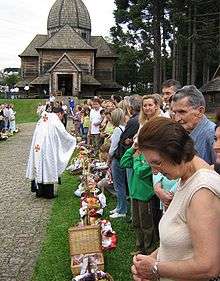


According to the 2010 IBGE Census, 2,469,489 people resided in the city of Curitiba.[30] The census revealed 1,381,938 White people (78.9%), 294,127 Pardo (Multiracial) people (16.8%), 49,978 Black people (2.9%), 23,138 Asian people (1.4%), 2,693 Amerindian people (0.2%).[31]
In 2010, Curitiba was Brazil's 8th most populous city.[32]
In 2010, the city had 359,201 opposite-sex couples and 974 same-sex couples. The population of Curitiba was 52.3% female and 47.7% male.[31]
As with most of Southern Brazil's population, Curitiba is mostly inhabited by European descendents. The first Europeans to arrive were of Portuguese origin, during the 17th century. They intermarried with the native people and with the African slaves.[33]
Up until the 19th century, the inhabitants of the city of Curitiba were natives, mixed-raced, Portuguese and Spanish immigrants. Immigration became appealing as of 1808, when in a decree promulgated by the then Ruling Prince Dom João VI, foreigners were granted the right to ownership of land. After Independence of Brazil in 1822, the country began to worry even more about its territory and the settlers on its lands. In Curitiba, this concern became even worse as of 1853, when Paraná, which belonged to the Judicial District of São Paulo, became an independent Province. During this period, European immigrants began arriving in hordes.[34]
The Memorial of Polish Immigration was inaugurated on 13 December 1980, after the visit of the Pope John Paul II in June. Its area is 46,000 square metres (500,000 sq ft) and was part of the former Candles plant. The seven wooden log houses are parts of this memorial area, as a souvenir of the Polish immigrants' struggles and faith. Objects like an old wagon, pipe of cabbage and a print of the Black Madonna of Częstochowa (patron saint of Polish people), form parts of the memorial.[35]

The first group of Polish arrived in Cutitiba around 1871. Curitiba has the biggest colony of Polish immigrants in Brazil.
The first non-Iberic (Portuguese and Spaniard) immigrants to come to the city were German.[36]
Italian immigrants started arriving in Brazil in 1875 and in Curitiba in 1878 coming mainly from the Veneto and Trento regions of Northern Italy. They settled mostly in the Santa Felicidade neighborhood, still a centre of the Italian community.[37]
Nearly 20,000 Ukrainian immigrants settled there between 1895 and 1897, consisting mostly of peasants from Galicia who emigrated to Brazil to become farmers. Around 300,000 Ukrainian-Brazilians live in Paraná.[38][39] The State of Paraná has the largest Ukrainian community and Slavic community.[40]
Curitiba has a Jewish community[41] that was originally established in the 1870s.[42] Much of the early Jewish congregation has been assimilated.[43] In 1937 with the rise of Nazi Germany, notable German Jewish academics migrated to Brazil, some settling in Curitiba.[44] Physicist César Lattes and former mayors Jaime Lerner[45] and Saul Raiz were Jewish. A Holocaust memorial is present in the city. The community centre, a Jewish school, a Chabad house (Beit Chabad),[46] a synagogue,[47] and two Jewish cemeteries are there,[48] one of which was defiled in 2004.[49]
Japanese immigrants began arriving in 1915, with a larger contingent arriving in 1924. Curitiba received a significant Japanese influx. They settled mostly between Paraná and São Paulo state. The city has the second largest Japanese community in Brazil, behind only São Paulo, according to IBGE. Although both cities have around the same proportion of Japanese descendants, other large cities in the countryside, such as Maringá and Londrina, have an even higher rate. Some estimates suggest that more than 40,000 Japanese-Brazilians living in Curitiba.[50]
The city elected in 1996 Brazil's first Japanese descendant mayor of a state capital. Cássio Taniguchi served two consecutive terms, 1997–2000 and 2001–2004.
Economy
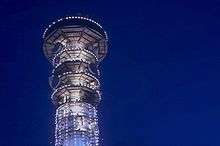
Since it was declared capital of the State of Paraná in 1853, the city has gone through several major urban planning projects to avoid uncontrolled growth and thus has become an international role model in dealing with issues including transportation and the environment.[51] The city is Brazil's second largest car manufacturer. Its economy is based on industry, commerce and services. For that reason, Curitiba is considered by many investors to be the best location for investment in Brazil.
The city receives more than two million tourists every year. Most arrive via Afonso Pena International Airport, where almost 60,000 flights land annually.[52]
According to IPEA data, the GDP in 2006 was 32 billion reals, without including agriculture and livestock (0.03%). Industry represented 34.13% and the commerce and service sectors 65.84%.[53] Cidade Industrial de Curitiba, the industrial district, is home to many multinational industries, such as Nissan, Renault, Volkswagen, Philip Morris, Audi, Volvo, HSBC, Siemens, ExxonMobil, Electrolux and Kraft Foods, as well as many well-known national industries, such as Sadia, O Boticário and Positivo Informática.
Curitiba's infrastructure makes bus travel fast and convenient, effectively creating demand for bus use in the same way that the infrastructure of traditional cities creates demand for private motor vehicles. In July 2001, Curitiba became Brazil's first city to receive the prize "Pole of Information Technology", granted by InfoExame magazine. According to the magazine, the companies of "Technology and Information Technology" based in Curitiba in 2001 achieved US$1.2 billion in revenues, representing a growth of 21% over the previous year.[54]
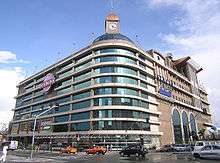
The city's 30-year economic growth rate is 7.1%, higher than the national average of 4.2%, and per capita income is 66% higher than the Brazilian average. Between 1975 and 1995, Curitiba's domestic product grew by some 75% more than the entire State of Paraná, and 48% more than Brazil as a whole. In 1994, tourism generated US$280 million, 4% of the city's net income. Curitiba has municipal health, education and day care networks, neighborhood libraries shared by schools and citizens and Citizenship Streets, where buildings provide essential public services, sports and cultural facilities near transportation terminals. At the Open University, residents can take courses in subjects such as mechanics, hair styling and environmental protection for a small fee. Policies for job creation and income generation became part of the city's strategic planning in the 1990s, for the metropolitan area as well as the city.[55]
Since 1990, the Municipal Housing Fund has provided financial support to housing for lower income populations. After national housing finance collapsed in 1985, just as people from the countryside poured into Curitiba, the city's public housing program bought one of the few remaining large plots of land, "Novo Bairro" (New Neighborhood), as home for 50,000 families. While landowners built the houses themselves, each received a pair of trees and an hour's consultation with an architect to help them develop their plan. COHAB also built Technology Street, an avenue of 24 homes in the centre of Novo Bairro, each built using different construction techniques.[56]
Seven massive shopping malls are found in Curitiba shopping: Mueller, Estação, Curitiba, Crystal, Palladium, Patio Batel and Park Barigüi. The Rua das Flores (Street of Flowers) is home to the majority of stores. The area is pedestrianized, with no cars around the centre. An essential element of Curitiba shopping is the Feira do Largo da Ordem, or Largo da Ordem Street Fair.[57]
In 2008, according to IBGE Curitiba´s nominal GDP was R$45.7 billion (or about of US$22.5 billion)[58] (with R$25,934, or US$13,000, by nominal GDP per capita, about of US$5,000 more than Brazilian 2008 nominal GDP per capita), making it the fourth richest city in the country, after only São Paulo, Rio de Janeiro and the capital Brasília.
Curitiba is the 2nd Pole on Technological Innovation in Brazil, according to IPEA (Applied Economic Research Institute). The 2nd Brazil's Best City for Business and 5th South American Best City for Business, according to America Economia Magazine/2005 and 2006. The Best Destination for Business, according to Veja Magazine of 2007. The 3rd position among the Champions of Infrastructure, Exame Magazine of 2006. The 2nd Best City to Work in Southern Brazil, according to Você S.A. Magazine of 2005. The 49th Position, MasterCard Worldwide Centers of Commerce: Emerging Markets Index of 2008. One of the highlights according to the survey Offshoring Horizons performed by Watson Wyatt of 2007. One of the 10 global sustainability centres, according to Ethisphere Institute of 2008.[59]
Tourism and recreation
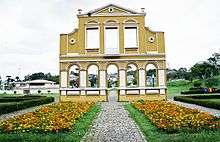
Attractions in the city include:
- German Woods: Opened in 1996, the German Grove honors the culture and traditions that German immigrants brought to Curitiba. It is a memorial to those immigrants who arrived in the city from 1833 and greatly contributed to the lifestyle of Curitiba. The grove has many other attractions. The Oratory Bach, a hall for concerts. The Tower of the Philosophers, with a gazebo. The Hansel and Gretel trail. The Haunted house, with a children's library. The Square of the German Culture. In addition to the native forest woods and freshwater springs.
- Municipal Market: It isn't a normal market, there are a lot of organic products, and vegan food. The food court has a lot of Asian food, vegan food and organic too. There you will find everything and more. It is located in downtown, next to the bus station of Curitiba.
- Italian Woods: Hosts local celebrations.[60]
- Japan Square: Homage to Japanese immigrants who settled there to work in agriculture. Scattered around the square are 30 cherry trees sent from Japan and artificial lakes. In 1993 the Japanese Portal, the Culture House and the Tea House were built.
- Tingüi Park: Part of the biggest linear environmental park in the Country, established at the Barigüi river margins, it reminds us of original inhabitants, including a statue of Tindiqüera Chieftain. The Ukrainian Memorial is also there, a replica of an Orthodox church, originally built in inland Paraná State, hosting pysankas (Ukrainian Pascha eggs) and an icon exhibition.
- Wire Opera House: Built on the site of an abandoned quarry.[61]
- Oscar Niemeyer Museum: Artists from Paraná and other parts of Brazil have their work represented in the museum. Three rooms in the Eye are dedicated exclusively to photography.[62]
- Tanguá Park: Inaugurated in 1996, the Tanguá Park was built on top of a complex of deactivated quarries. It is part of the Barigüi river preservation project joining Tingüi and Barigüi parks. This area is 450,000 square metres (4,800,000 square feet) covers two quarries connected by a 45-metre (148-foot) tunnel that may be crossed on foot by a path over the water. It can be visited on boat or on foot (hiking). The park has a cooper and bicycle track, snack bar, belvedere and Poty Lazzaroto garden.
- Panoramic Tower: The 360-foot tall lookout tower allows travelers a 360° view of Curitiba and has a telephone museum on the ground floor.[62]
- Portugal Wood: Homage to the Portuguese-Brazilian bonds, this space is highlighted by a track following a small brook, where one can see drawn on tiles excerpts from famous Portuguese language poets, as well as a tribute to the great Portuguese navigators and their discoveries.
- Botanical Garden: Besides having a treasure trove of native plants, the Curitiba Botanical Garden is also known for its greenhouse, made of iron and glass and inspired in London's Crystal Palace.[62] Families are often seen picnicking on the grounds.
- Curitiba International Ecological Marathon: The Maratona Ecológica Internacional de Curitiba ("Curitiba International Ecological marathon") is held in November and is known as the hardest in Brazil,[63] because it happens in the end of the year in the summer heat, and because of the hilly course.
- Tourism Line: The Linha Tourismo bus stops at key tourist attractions in the city.[64]
- Feirinha do Largo da Ordem, an open-air market place that happens every Sunday morning, in the historical centre of the city. In the Feirinha, visitors can see or buy paintings, sculptures, craftsmanship, workmanship, typical foods. It is also possible to watch live small musical shows from local musicians or see some clowns doing humorous performances.
- Cyclist pocket square: A brief square located nearby Largo da Ordem, in the corner of the streets Sao Francisco and Presindente Farias made by the community members with little help from the government. Made with the main objective of being a hotspot for city bikers, it has many pubs and cafés. It also helps on influencing people on changing their way of transiting inside the city, bikes over cars, which good for the environment. The square also supports a new concept of green in the grey, so people can grow plants in the middle of the downtown. The square is a refuge for street art, it has plenty space in the walls and in the street Sao Francisco.
Education
More than 183 universities operate in the state of Paraná.[65]
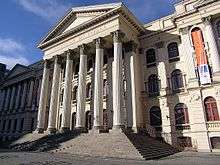
Tertiary educational institutions
- Universidade Federal do Paraná (UFPR) – Federal University of Paraná – This federal university is the largest of Paraná, with more than 20.000 students. The first university of Brazil;
- Universidade Tecnológica Federal do Paraná (UTFPR) – Federal Technologic University of Parana is the first university of technology from Brazil;
- Instituto Federal de Educação, Ciência e Tecnologia do Paraná - Paraná Federal Institute of Education, Science and Technology;
- Universidade Positivo (UP) - University Positivo
- Universidade Estadual do Paraná (UNESPAR) - State University of Paraná;
- Pontifícia Universidade Católica do Paraná (PUCPR) – Pontifical Catholic University of Parana - A major private university
- ESIC Business and Marketing School – International Website ESIC
- Centro Universitário Curitiba (UNICURITIBA) - University Center Curitiba, old Law School of Curitiba.[67]
- Centro Universitário Internacional (UNINTER)
- Fundação de Estudos Sociais do Paraná (FESPPR) - The First Economy Graduation in Paraná, since 1938
Primary and secondary schools
International schools:
- École Renault do Brasil - Mlf (French school)
- International School of Curitiba (American school)
In addition Colégio Suíço-Brasileiro de Curitiba is in nearby Pinhais.
Educational system
In the 1990s, the city started a project called Faróis do Saber ("Lighthouses of Knowledge"). These lighthouses are free educational centres that include libraries, Internet access and other cultural resources. Libraries work with municipal schools, offering a collection of approximately 5000 books, and provide cultural reference and leisure.[68]
Among Brazilian capitals, Curitiba has the highest literacy rate,[69] and also rank number 1 in education among the Brazilian capitals.[70]
Urban planning

Curitiba has a planned transportation system, which includes lanes on major streets devoted to a bus rapid transit system. The buses are split into three sections (bi-articulated) and stop at designated elevated tubes, complete with access for disabled riders. Buses charge one price regardless of distance.[71]
The city preserves and cares for its green areas, boasting 51.5 square metres (554 sq ft) of green space per inhabitant.[72]
In the 1940s and 1950s, Alfred Agache, cofounder of the French Society for Urban Studies, was hired to produce the first city plan. It emphasised a star of boulevards, with public amenities downtown, an industrial district and sanitation. The plan was too expensive to complete.[73]
By the 1960s, Curitiba's population had reached 430,000. Some residents feared that the growth in population threatened to damage the character of the city. In 1964, Mayor Ivo Arzua solicited proposals for urban design. Architect Jaime Lerner, who later became mayor, led a team from the Universidade Federal do Paraná that suggested strict controls on urban sprawl, reduced traffic in the downtown area, preservation of Curitiba's Historic Sector and a convenient and affordable public transit system.[74]
This plan, known as the Curitiba Master Plan, was adopted in 1968. Lerner closed XV de Novembro St. to vehicles, because it had high pedestrian traffic. The plan had a new road design to minimise traffic: the Trinary Road System. This used two one-way streets moving in opposite directions that surround a smaller, two-lane street where the express buses have an exclusive lane. Five of these roads form a star that converges on the city centre. Land farther from these roads is zoned for lower density development, to pull traffic away from the main roads. In a number of areas subject to floods, buildings were condemned and the land became parks.[75]
Today, Curitiba is considered one of the world's best examples of urban planning.[76] In June 1996, the chairman of the Habitat II summit of mayors and urban planners in Istanbul praised Curitiba as "the most innovative city in the country."[77]
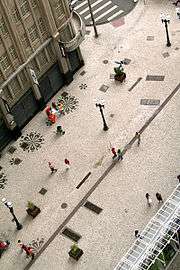
Curitiba was recently recommended by UNESCO as a model for the reconstruction of the cities of Afghanistan.[78] In the 1980s, the RIT (Rede Integrada de Transporte, Integrated Transport Network) was created.[79] At the same time, the city began building the "Faróis de Saber" (Lighthouses of Knowledge) educational centres.[80] The city has more than 400 square kilometres (154 sq mi) of public parks and forests.[81]
In 2007, the city placed third in a list of "15 Green Cities" in the world, according to "Grist" magazine, after Reykjavík in Iceland and Portland, Oregon in the United States. As a result, according to one survey, 99% of Curitibans are happy with their hometown.[82] The "green exchange" employment program focuses on social inclusion, benefiting both those in need and the environment. Low-income families living in shantytowns unreachable by truck bring their trash bags to neighborhood centres, where they exchange them for bus tickets and food. This means less city litter and less disease, less garbage in sensitive areas such as rivers and a better life for the undernourished poor. There's also a program for children where they can exchange recyclable garbage for school supplies, chocolate, toys and tickets for shows.
Jaime Lerner suggests urban acupuncture as the future solution for contemporary urban issues; focusing on very narrow pressure points in cities, can create positive ripple effects. Urban "acupuncture" reclaims land for the public and emphasizes the importance of community development through small interventions in design of cities.[83] It emphasises pinpoint interventions that can be accomplished quickly to create a make an immediate impact.[84] He stated:
I believe that some medicinal "magic" can and should be applied to cities, as many are sick and some nearly terminal. As with the medicine needed in the interaction between doctor and patient, in urban planning it is also necessary to make the city react; to poke an area in such a way that it is able to help heal, improve, and create positive chain reactions. It is indispensable in revitalizing interventions to make the organism work in a different way.[85]
Under the "Garbage? That's not garbage!" program, 70% of the city's trash is recycled by its residents. Once a week, a truck collects paper, cardboard, metal, plastic and glass that has been sorted by residents. The city's paper recycling saves the equivalent of 1,200 trees a day. Money raised from selling materials goes into social programs and the city employs the homeless and alcoholics in its garbage separation plant.
Open University, created by the city, lets residents take courses in many subjects such as mechanics, hair styling and environmental protection for a small fee. Retired city buses are often used as mobile schools or offices. Downtown areas were transformed into pedestrian streets, including a 24-hour mall (the Rua 24 Horas) with shops, restaurants and cafés, and a street of flowers with gardens tended by street kids.
The "capacity building job line" was created to accelerate economic development. Key initiatives include the South-Circular bus line, which links the southern and eastern regions of town; Entrepreneurial "Sheds", business incubators designed to help small companies get established and prosper; and the Crafts Lycée, which trains people for professions such as marketing and finance. Specifically, the goal is to provide jobs and income for the unemployed among 400,000 people living in 15 peripheral towns, and to structure and develop the region according to integrated planning principles. About 15,000 new jobs were generated by 2013.[86]
The transit service is used by more than 2 million people a day. Curitiba has more car owners per capita than anywhere else in Brazil. The population has doubled since 1974, yet auto traffic declined by 30%, and atmospheric pollution is the lowest in Brazil.[87]
Culture
Culture has always held a crucial role in the development of the city of Curitiba and that granted the city nationwide attention, during the 1970s. With the inauguration of the Teatro Paiol, a deactivated warehouse formerly used for stocking army ammunition, many different artists came to perform in its arena, ranging from local artists of various genres. In January 1973, the Fundação Cultural de Curitiba was officially set up, with the aim of promoting culture and of acting as a facilitating agent in the cultural production of the city.[88]
The Fundação Cultural de Curitiba currently has a broad infrastructure, made up of a specialized staff, 150 sites for cultural events in 50 different buildings throughout the city. Culture pervades all of the city's districts, through the set up of cultural centres, libraries, museums, movie theaters, theaters, exhibit rooms, and studios, all equipped to meet the needs of the artists and of the community that these cultural spaces attend.[88]
The foundation is also responsible for the preservation, conservation and research of the cultural heritage of Curitiba. Its headquarters are located in a building registered and protected as part of the State's Historical Patrimony, the Palacete Wolf (Wolf Mansion), built in 1877, in the Largo da Ordem, a Historical Area of Curitiba. In the Foundation's courtyard, there is the Piá Theater (piá being a local term used to refer to youngsters). This theater was inaugurated in 1973 and is the first public space in the country for puppet and marionette shows.[88]

The Historical Sector is another innovation brought by the new policies regarding culture in the city. In the 1970s, when people were still talking about preserving individual buildings, Curitiba passed a law to preserve the city's entire historical sector, an innovative policy which later was adopted throughout the entire country. The cultural spaces that Curitiba boasts are tourist attractions in themselves. The Parque das Pedreiras (Quarries Park), for example, includes an area that was once a stone quarry and has now been named the Pedreira Paulo Leminski, as well as a theater called the Ópera de Arame (an opera house built entirely of metallic structures and glass), that can accommodate audiences of 30,000 people. Performers that have been on its stage include names such as the Spanish tenor José Carreras, stars from the Brazilian Popular Music movement, Paul McCartney and others.[88]
The Guaíra Theater, maintained by the state government, is one of the largest theaters in all of South America. The Oscar Niemeyer Museum is one of the most impressive projects created and carried out by one of Brazil's architecture masterminds, Oscar Niemeyer. The Frans Krajcberg Cultural Space lies in the Botanical Gardens, one of the city's most famous parks. This space holds 114 large-scale sculptures and three carvings in relief made out of trunks of trees, these works are in the process of being donated to the city. It is the first place in the world that was specifically designed to house the works of this Polish.[88]
The Cultural Complex Solar do Barão, located in Downtown Curitiba, features the Photography Museum, the Engravings Museum and the Posters Museu. There is also a space called "Gibiteca", a comic books library. The Gibiteca, inaugurated in 1982, is a national pioneer and holds exhibits, comic strips contests, fairs and workshops. It has more than 10,000 members and around 45,000 books. The MuMA - Museu Metropolitano de Arte (Museum of Metropolitan Art) displays its permanent collection of artists from the state of Paraná as well as renowned Brazilian painters such as Pancetti, Guignard, Di Cavalcanti, Djanira, Portinari, Mário Cravo, Burle Marx.[88]
When it comes to music, the Brazilian Popular Music Conservatory deserves all the attention. The institution maintains wind and string orchestras, not to mention the Brasileirão and the Brasileirinho choirs. The city also proudly maintains the renowned Curitiba's Camerata Antiqua, which is the most important ensemble in Brazil when it comes to musica antiqua. The Fundação Cultural de Curitiba has been hosting the largest music workshop in South America every year since 1982. It lasts 20 days and around 2,000 students take part in its activities, while a total public of 21,000 people attend the more than 100 concerts.[88]
Several cultural events also take place at Curitiba's parks, paying tribute to its various ethnic groups that have settled in the region since the 19th century. At the Tingüi Park you will find the Ukrainian Memorial. The architectural complex includes a portal and a replica of the old Saint Michael chapel, built at the top of the Serra do Tigre mountain range. The chapel is adorned with a golden dome and is made of wood, in a typical Byzantine style. Visitors will always find a permanent exhibit of the famous pysanky (Ukrainian decorated Easter eggs), religious icons and embroidered items.[88]
The Polish Immigrants Memorial, also known as The Pope's Woods, offers an enjoyable area surrounded by trees, which makes it a perfect choice for a stroll. The Pope himself blessed the first replica of the traditional Polish houses that beautifully make up the Bosque do Papa when he visited the city in 1980.
In 2003, Curitiba received the "American Capital of Culture" title, granted by the OAS (Organization of American States).[88]
Arts and entertainment
Curitiba was Brazil's first city to have an IMAX movie theatre.[89] Curitiba has many theaters. The largest and most important one is the Guaíra Theater.[90] Every year, in April, it hosts the Curitiba Theater Festival.
Museums
Brazilian architect Oscar Niemeyer designed the extravagant state museum of Curitiba. Its design includes a gravity-defying construction that was intended to look like a Paraná Pine, one of the city's symbols, but is widely interpreted by locals as an eye, which gave the Museum its nickname – Museu do Olho, or Museum of the Eye. In keeping with Curitiba's history and culture of science, the museum offers many science exhibitions, including biennial exhibitions. The Curitiba museum includes the Oscar Niemeyer auditorium.[91]
- Museu Paranaense ("Paranaense Museum") – dedicated to arts and history;
- Oscar Niemeyer Museum – the largest museum of South America,[92] dedicated to plastic arts;
- Museu de Arte Sacra ("Religious Art Museum") – the focus is Christian art;
- Museu do Expedicionário ("Museum of Expeditionary") – dedicated to Brazilian participation in World War II;
- Museu de Arte Contemporânea ("Museum of Contemporary Art");
- Museu da Imagem e do Som ("Image and Sound Museum") – about cinema and photography;
- Museu Metropolitano de Arte de Curitiba ("Metropolitan Museum of Art in Curitiba") – modern art;
- Museu de História Natural ("Natural History Museum") – biology and botany.
- Museu do Holocausto ("Holocaust Museum") [93]
Festivals
Curitiba has yearly festivals related to arts, such as Curitiba Theatre Festival[94] and the Music Workshop of Curitiba.[95] Others celebrate immigrants festivals, such as the Grape Feast ("Festa da Uva"),[96] which is related to Italian immigrants, and the four Matsuri, related to Japanese immigrants.
The four Matsuri set in Curitiba are: Imin Matsuri (Japanese: 移民祭り, "Immigration Festival") which celebrates the arrival of Japanese immigrants in Brazil,[97][98] Haru Matsuri (Japanese: 春祭り, "Spring Festival") which celebrates the end of winter and coming of spring,[99] Hana Matsuri[100] (Japanese: 花祭り, "Flower Festival"), which celebrates the birth of Sakyamuni,[101] and Seto Matsuri ("Seto Festival"), in honor of Cláudio Seto,[102] comic artist, precursor of the manga in Brazil and idealist of the first Matsuri in Curitiba.
Curitiba also hold the famous Psycho Carnival,[103] a three-day festival that happens during the Brazilian Carnival, but devoted to psychobilly and rockabilly genres, attracting people from all over the world. In the same occasion the Zombie Walk also happens. The 2016 edition took more than 20.000 people to the streets.[104]
UN Convention on Biodiversity
On 20–31 March 2006 the Convention on biodiversity took place in Pinhais (a city near Curitiba), addressing items of the 1993 Convention on Biological Diversity adopted by 188 countries.[105]
Transportation
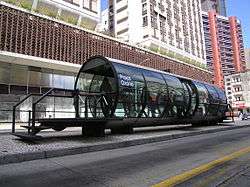
Public transport
Curitiba's public transportation consists entirely of buses. It opened the world's first bus rapid transit (BRT) system, Rede Integrada de Transporte, in 1974.[106] The popularity of Curitiba's BRT has effected a modal shift from automobile travel to bus travel. Based on 1991 traveler survey results, it was estimated that the introduction of the BRT had caused a reduction of about 27 million auto trips per year, annually saving about 27 million liters of fuel. In particular, 28 percent of BRT riders previously traveled by car. Compared to eight other Brazilian cities of its size, Curitiba uses about 30 percent less fuel per capita, resulting in one of the country's lowest rates of ambient air pollution. Some 1,100 buses make 12,500 trips every day, serving more than 1.3 million passengers, 50 times the number from 20 years ago. Eighty percent of travelers use the express or direct bus services. Curitibanos spend only about 10 percent of their income on travel, much below the national average.[107]
The city government has been planning to introduce an underground metro for a number of years and in 2014 announced opened tenders for a 35-year public private partnership contract to build and operate a 17.6-kilometre (10.9-mile), 14-station north-south line. The cost is estimated at 4.62 billion reals.[108]
Roads
Moving around in a car can be difficult in and around the city centre because of the many one-way streets and frequent traffic jams. The Trinary Road System allows quick access to the city centre for drivers. Some avenues are spacious and laid out in a grid. Apart from some points around the city centre, Munhoz da Rocha Street and Batel Avenue, traffic jams are not severe.[109]
Air
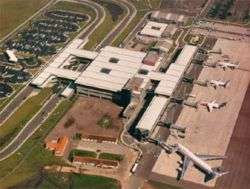
Afonso Pena International Airport is Curitiba's main airport. It is located in the nearby city of São José dos Pinhais. All commercial flights operate from this airport.[110]
There is also the Bacacheri Airport, a smaller general aviation facility.
Others
The city has 100 km (62 mi) of bike routes, used by around 30 thousand bikers daily. City streets carry almost one million vehicles, of which 2,253 are orange Taxis. To service these vehicles, more than 355 petrol stations serve the city.[111]
Sports
Several association football teams play in Curitiba, Coritiba plays at Estádio Major Antônio Couto Pereira, Clube Atlético Paranaense at Estádio Joaquim Américo Guimarães. Both Coritiba and Atlético Paranaense have won Campeonato Brasileiro Série A, in 1985 and 2001, respectively. Estádio Joaquim Américo Guimarães was one of the 12 stadiums to host games of the 2014 FIFA World Cup held in Brazil. The stadium Vila Capanema have hosted the 1950 FIFA World Cup which still is home to Paraná Clube.[112] Clube Atlético Paranaense (Brazilian champion of 2001, several times champion of the state of Paraná). Arena da Baixada is one of the three privately owned stadiums of the 2014 FIFA World Cup. The other two are Beira-Rio stadium, in Porto Alegre and Arena Itaquera, in São Paulo. Arena da Baixada is considered one of the most modern stadiums in Brazil (it was the first to offer free Wi-Fi, and one of the few with a central surveillance system). This is the lowest budget of all venues of the 2014 FIFA World Cup, and again it has to do with the fact that the stadium is privately owned. Most of the original stadium was preserved, and just an expansion is planned; today's capacity is 25,000, which should be increasead to about 42,000.[113]
The Autódromo Internacional de Curitiba (Curitiba International Raceway) is located in nearby Pinhais.
Curitiba has also one of the main rugby union clubs in Brazil, Curitiba Rugby Clube, national champions in 2014.
Neighbourhoods
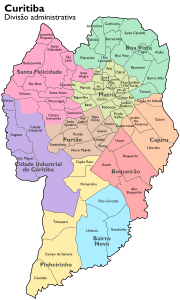
Bairros (neighbourhoods) of Curitiba define the city's geographical divisions. Administrative powers are not delegated to neighborhoods, although neighborhood associations work to improve their communities. Curitiba is divided into 9 regional governments (boroughs) covering the 75 neighbourhoods.
Most districts of Curitiba were born of colonial groups formed by families of European immigrants in the second half of the nineteenth century.
The centro (downtown or central business district), was where the city was founded, is the most bustling area, which concentrates most of the financial institutions of Curitiba.
List of neighborhoods by region:
- Matriz: Centro, Centro Cívico, Batel, Bigorrilho, Mercês, São Francisco, Bom Retiro, Ahu, Juvevê, Cabral, Hugo Lange, Jardim Social, Alto da XV, Alto da Glória, Cristo Rei, Jardim Botânico, Prado Velho and Rebouças;
- Santa Felicidade: Santa Felicidade, Lamenha Pequena, Butiatuvinha, São João, Vista Alegre, Cascatinha, São Brás, Santo Inácio, Orléans, Mossunguê, Campina do Siqueira, Seminário, CIC (north region) and part of Campo Comprido;
- Boa Vista: Boa Vista, Bacacheri, Bairro Alto, Tarumã, Tingüi, Atuba, Santa Cândida, Cachoeira, Barreirinha, Abranches, Taboão, Pilarzinho and São Lourenço;
- Cajuru: Cajuru, Uberaba, Jardim das Américas, Guabirotuba and Capão da Imbuia;
- Fazendinha/Portão: Portão, Fazendinha, Santa Quitéria, Vila Isabel, Água Verde, Parolin, Guaíra, Lindóia, Fanny, Novo Mundo and part of Campo Comprido;
- Boqueirão: Boqueirão, Xaxim, Hauer and Alto Boqueirão;
- Pinheirinho: Pinheirinho, Capão Raso, Tatuquara, Campo de Santana and Caximba;
- Bairro Novo: Sítio Cercado, Ganchinho and Umbará;
- Cidade Industrial de Curitiba: CIC (centre and south region), Riviera, Augusta and São Miguel.
International relations
Twin towns – Sister cities
Curitiba is twinned with:
Cooperation agreements
In addition Curitiba has cooperation agreements with:
Notable people
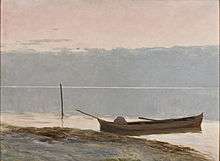
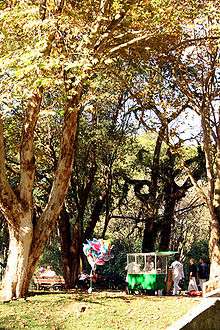
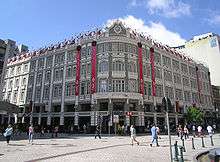
Architecture
Arts
- Alfredo Andersen – Norwegian Painter and Sculptor[122]
- Alexandre Slaviero - Actor
- Andrade Muricy – Composer and Musical and Literary Critic[123]
- Dalton Trevisan – Writer
- Dinho Ouro Preto – Rock Musician
- Emílio de Meneses – Poet and Journalist, "immortal" of the Brazilian Academy of Letters[124]
- Fernanda Machado – Actress
- Francisco Lachowski – Super Model
- Guido Viaro – Italian Painter and Teacher[125]
- Guilherme Weber – Actor
- Guta Stresser – Actress
- Icarius De Menezes – Creative Director
- Isabeli Fontana – Super Model
- Isadora Ribeiro – Actress
- Jaime Lerner – Architect and Urbanist
- Katiuscia Canoro – Actress
- Karol Conká - Singer
- Luís Melo – Actor
- Luiz Carlos Alborghetti – TV host
- Marjorie Estiano – Actress and Singer
- Relespública – Rock band
- ruído/mm – Experimental/Post-rock band
- Paulo Leminski – Poet and Writer
- Simone Spoladore – Actress
- Tasso da Silveira - Poet, Journalist, Deputy and Professor[126]
Aviation
- Pierre Clostermann – World War II French Pilot, engineer
- Egon Albrecht-World War II German Flying Ace
Science
- Alex Kipman - Scientist
- César Lattes – Physicist
- Ned Kock – Systems Scientist
- Newton da Costa – Mathematician
- Ricardo Ramina – Physician
Politics
- Carlos Alberto "Beto" Richa - Governor of the State of Paraná
- Gustavo Fruet - Mayor of the City of Curitiba
- Roberto Requião de Mello e Silva - Former Governor of the State of Paraná
Sports
- Football
- Mixed martial arts
- Motorsports
- Augusto Farfus – DTM driver for BMW.
- Enrique Bernoldi – Formula One driver – IndyCar driver
- Raul Boesel – Formula One driver – IndyCar driver. 1987 World Sportscar Championship champion.
- Ricardo Zonta – Formula One driver. 1998 FIA GT Championship champion
- Matheus Carneiro - Mystery Science Theater F1 creator and host
- Basketball
- Rolando Ferreira – (Gold medalist at the 1987 Pan American Games). Former Portland Trail Blazers player
- Beach Volleyball
- Emanuel Rego (Gold medalist in 2004 Olympics, Bronze in 2008 Olympics and Silver in 2012 Olympics)
- Agatha Bednarczuk (Silver medalist in 2016 Olympics)
- Poker
- Alexandre Gomes (WSOP and WPT world champion 2008–2009)
References
- ↑ ftp://ftp.ibge.gov.br/Estimativas_de_Populacao/Estimativas_2015/estimativa_dou_2015.pdf
- ↑ "Mapa da Região Metropolitana de Curitiba – Paraná". Curitiba-parana.com. Retrieved 22 July 2009.
- ↑ Primeiros resultados do Censo 2010 at the Wayback Machine (archived 14 June 2011)
- ↑ Curitiba
- 1 2 "Tradições Culturais" (in Portuguese). Curitiba-parana.net. Retrieved 7 March 2011.
- ↑ "A imigração árabe muçulmana em Curitiba" (in Portuguese). Etni-cidade. Retrieved 3 October 2008.
- ↑ "Dados do IBGE sobre Curitiba" (in Portuguese). IBGE. Retrieved 31 July 2011.
- ↑ "Cidades Brasileiras, Curitiba" (in Portuguese). SuaPesquisa. Retrieved 31 July 2011.
- ↑ "Quase metade de Curitiba é dos "estrangeiros"" (in Portuguese). Bem Paraná. Retrieved 6 August 2008.
- ↑ "The Brazilian city Curitiba awarded the Globe Sustainable City Award 2010". globeforum.com. Retrieved 7 July 2014.
- ↑ "Brazil Outsourcing: Curitiba Comes On Strong as 'Silicon Valley South'". Nearshore Americas. Retrieved 3 January 2013.
- ↑ "Bestcitiestolivein.net". Bestcitiestolivein.net. Retrieved 3 January 2013.
- ↑ http://planetasustentavel.abril.com.br/album/10-capitais-mais-seguras-jovens-brasil-indice-vulnerabilidade-violencia-734424.shtml?&foto=4
- 1 2 Fenianos, E. (2003) Almanaque Kur'yt'yba, Curitiba: Univer Cidade, p.6
- ↑ "Curitiba name origin". Inf.ufpr.br. 20 October 2004. Retrieved 7 March 2011.
- ↑ Government - Curitiba
- ↑ A city for people, not for cars
- ↑ Former Curitiba Mayor Jaime Lerner
- 1 2 3 4 5 History of Curitiba
- 1 2 History of Curitiba
- ↑ "The Agache Plan". Prefeitura Municipal de Curitiba. Retrieved 12 August 2008.
- ↑ Climate of Curitiba
- ↑ "SYNOP: SUMMARIZED DATA FOR CURITIBA". Mundomanz. Retrieved 25 July 2013.
- ↑ "METAR: Weather History for Curitiba, Brazil". Weather Underground. Retrieved 25 July 2013.
- ↑ "Frente fria traz chuva ao Paraná e aumenta taxas de umidade" (in Portuguese). Bemparana.com.br. Retrieved 7 March 2011.
- ↑ "Winter of Curitiba is dry and cold". Portal.rpc.com.br. Retrieved 7 March 2011.
- ↑ "NORMAIS CLIMATOLÓGICAS DO BRASIL 1961-1990" (in Portuguese). Instituto Nacional de Meteorologia. Retrieved 4 July 2015.
- 1 2 3 "City of Curitiba, Brazil". Convention on Biological Diversity. Retrieved 23 May 2008.
- ↑ "Livro mostra roteiros das árvores de Curitiba/Pr" (in Portuguese). Ambiente Brasil. Retrieved 25 May 2005.
- ↑ 2010 IGBE Census (Portuguese)
- 1 2 2010 IGBE Census (Portuguese)
- ↑ The largest Brazilian cities - 2010 IBGE Census (in Portuguese)
- ↑ "Internet Archive Wayback Machine". Web.archive.org. 3 July 2007. Archived from the original on 3 July 2007. Retrieved 16 September 2011.
- ↑ The Curitibano
- ↑ "Polish Memorial of Curitiba". Parques-curitiba.com. Retrieved 7 March 2011.
- ↑ "The 'Curitibano". Prefeitura de Curitiba. Retrieved 19 March 2013.
- ↑ "Imigração e Cultura Italiana" (in Portuguese). Curitiba-parana.net. Retrieved 7 March 2011.
- ↑ "Ukrainian memorial in the city of Curitiba". Curitiba-parana.net. Retrieved 7 March 2011.
- ↑ "Paraná Government (Ukrainian community in the State)". .pr.gov.br. Archived from the original on 12 July 2010. Retrieved 7 March 2011.
- ↑ "Slavic community in Curitiba". Brasil.kiev.ua. Archived from the original on 3 December 2013. Retrieved 7 March 2011.
- ↑ Jews of Brazil site Source listing Curitiba as one of the important Jewish communities. A Habad article gives the number of 844 religious participating families there in the year 2007"Archived copy". Archived from the original on 15 August 2007. Retrieved 2008-06-05.
- ↑ Brazil's Jews during the Vargas Era and After by Robert M. Levine 1968. This is a book about early Jewish settlers in Brazil
- ↑ Digital edition of Levine's book. Books.google.co.uk. Retrieved 7 March 2011.
- ↑ A research paper about the Jewish immigration to Brazil during the second world war.
- ↑ "Jewish in Curitiba". Heschel.org.il. 18 April 2007. Archived from the original on 17 October 2010. Retrieved 7 March 2011.
- ↑ "Beit Chabad". Chabadcuritiba.com. Retrieved 7 March 2011.
- ↑ Israel Synagogue in addition to the Hevra Kadisha Synagogue and the Habad Synagogue mentioned in the Chabad reference
- ↑ Jewish Genealogy site lists cemeteries.
- ↑ "Stephen Roth Institute: Antisemitism And Racism". Tau.ac.il. 28 August 2004. Retrieved 7 March 2011.
- ↑ "Japan Square in Curitiba". Curitiba-parana.net. Retrieved 7 March 2011.
- ↑ Curitiba Economy – FIFA report Archived 5 May 2010 at the Wayback Machine.
- ↑ "Curitiba – Economic ranks". Brasilprimedesign.com. Archived from the original on 8 July 2011. Retrieved 7 March 2011.
- ↑ "GDP – Curitiba". Retrieved 7 March 2011.
- ↑ "A capital do Paraná se destaca na área de TI e oferece oportunidades para profissionais do setor." (in Portuguese). Revista TI. Retrieved 11 October 2003.
- ↑ "Economy – City of Curitiba". Hopebuilding.pbworks.com. Retrieved 7 March 2011.
- ↑ "Housing Program Curitiba". Hopebuilding.pbworks.com. Retrieved 7 March 2011.
- ↑ "Shopping in Curitiba, Brazil". Curitiba.info. Retrieved 7 March 2011.
- ↑ "Instituto Brasileiro de Geografia e Estatística". IBGE. Retrieved 3 January 2013.
- ↑ Curitiba Highlights
- ↑ "Curitiba Tourist Attractions and Sightseeing". World Guides. TravelSmart. Retrieved 19 March 2013.
- ↑ "The Wire Opera House: Curitiba's Most Original Theatre". Curitiba in English. 1 November 2010. Retrieved 18 March 2013.
- 1 2 3 Top 12 Curitiba Tourist Attractions
- ↑ "Maratona Ecológica de Curitiba – Ladeiras e incentivos do povo curitibano" (in Portuguese). Copacabana Runners. Retrieved 7 August 2008.
- ↑ "Getting Around, Curitiba Travel, Transport and Car Rental". World Guides. TravelSmart. Retrieved 19 March 2013.
- ↑ Universidades no Paraná
- ↑ UFPR – HistoryArchived 24 September 2008 at the Wayback Machine.
- ↑ "Unicuritiba". Unicuritiba. Retrieved 30 November 2013.
- ↑ "CURITIBA, UNA CITTÀ DA FANTASCIENZA" (in Italian). Eco Fantascienza. Archived from the original on 1 May 2008. Retrieved 18 October 2008.
- ↑ "Só 1% das cidades está livre de analfabetismo" (in Portuguese). O Estado de S. Paulo. Retrieved 23 June 2007.
- ↑ "Índice da Educação Básica" (in Portuguese). Jornal da Globo. Retrieved 28 April 2007.
- ↑ Jonas Rabinovitch and Josef Leitman, "Urban Planning in Curitiba", Scientific American, vol. 274, no. 3 (March 1996), pp. 46–53
- ↑ "Curitiba busca recuperação de biodiversidade local Terra – Ambiente". Noticias.terra.com.br. Retrieved 22 July 2009.
- ↑ "Prefeitura ENG". Curitiba.pr.gov.br. Retrieved 22 July 2009.
- ↑ About Curitiba Archived 25 November 2010 at the Wayback Machine.
- ↑ Parks of Curitiba and floods Archived 12 October 2006 at the Wayback Machine.
- ↑ Irazábal, Clara Elena (2002) Curitiba and Portland: Architecture, City Making, and Urban Governance in the Era of Globalization, PhD Dissertation in Architecture, University of California, Berkeley, p.112
- ↑ "Curitiba – urban plannig". Scielo.br. 31 March 1993. doi:10.1590/S0104-44782001000100007. Retrieved 7 March 2011.
- ↑ クリチバもモデルに=カブール復興計画に参加 (in Japanese). Nikkey Shimbun. Archived from the original on 3 November 2004. Retrieved 21 October 2008.
- ↑ "RIT Curitiba – Trajetory". Urbs.curitiba.pr.gov.br. Retrieved 7 March 2011.
- ↑ "Social programs in the city". Cmc.pr.gov.br. 16 May 2006. Retrieved 7 March 2011.
- ↑ Anil Mundra (27 December 2012). "Curitiba - Sustainable City". Green Planet Monitor. Retrieved 19 March 2013.
- ↑ "15 Green Cities". Grist. Retrieved 10 July 2007.
- ↑ Urban Acupuncture - Understanding Space 2011
- ↑ Curitiba: Jaime Lerner’s Urban Acupuncture - Bill Hinchberger, Brazilmax 2/2006
- ↑ "Urban Acupuncture: Revivifying Our Cities Through Targeted Renewal - Kyle Miller" MSIS 9/2011
- ↑ Curitiba a green city
- ↑ Curitiba – low pollution
- 1 2 3 4 5 6 7 8 9 Culture of Curitiba
- ↑ "Palladium Shopping Center". Shoppingpalladium.com.br. Retrieved 7 March 2011.
- ↑ "Teatro Guaíra". Tguaira.pr.gov.br. Retrieved 7 March 2011.
- ↑ "Museums in the city". Curitiba.info. Retrieved 7 March 2011.
- ↑ "Museu Oscar Niemeyer" (in Portuguese). Descubra Curitiba. Retrieved 17 January 2008.
- ↑ http://www.museudoholocausto.org.br
- ↑ "Festival de Teatro de Curitiba chega a sua 20ª edição com mais de 400 peças - 28/03/2011 - Da Redação". Entretenimento.uol.com.br. Retrieved 3 January 2013.
- ↑ Do G1 PR (9 January 2012). "G1 - Oficina de Música de Curitiba inicia neste domingo com música erudita - notícias em Paraná". G1.globo.com. Retrieved 3 January 2013.
- ↑ "51ª Festa da Uva de Curitiba - Gastronomia - Bonde. O seu portal". Bonde.com.br. 6 January 1990. Retrieved 3 January 2013.
- ↑ "Governador prestigia Imin Matsuri, tradicional festa da colônia japonesa - Paraná-Online - Paranaense como você". Parana-online.com.br. Retrieved 3 January 2013.
- ↑ "Vida e Cidadania". Gazeta do Povo. Retrieved 3 January 2013.
- ↑ "Haru Matsuri comemora chegada da primavera em Curitiba - Paraná-Online - Paranaense como você". Parana-online.com.br. Retrieved 3 January 2013.
- ↑ Tadaima! Curitiba (25 March 2011). "Evento: Hana Matsuri 2011". Tadaima! Curitiba. Retrieved 3 January 2013.
- ↑ "Hanamatsuri". Culturajaponesa.com.br. Retrieved 3 January 2013.
- ↑ Myrelle Silva (15 October 2010). "Eventos: Seto Matsuri dias 06 e 07 de novembro" (in Portuguese). Tadaima - Cultura Japonesa. Retrieved 24 January 2012.
- ↑ "Eventos: 2016 Psycho Carnival" (in Portuguese). February 2016.
- ↑ "Eventos: 2016 Zombie Walk" (in Portuguese). February 2016.
- ↑ "UN Convention on Biodiversity and Biosecurity". Cartamaior.com.br. Retrieved 7 March 2011.
- ↑ Schneider, Keith (23 October 2012). "Putting BRT in Car City, China". Next American City.
- ↑ Goodman, Joseph. "Urban transport of Curitiba". Urbanhabitat.org. Retrieved 7 March 2011.
- ↑ "Curitiba re-launches metro concession tender". July 8, 2014.
- ↑ "Roads in Curitiba". Hagah.com.br. 21 February 2011. Retrieved 7 March 2011.
- ↑ Afonso Pena International Airport Archived 20 October 2008 at the Wayback Machine.
- ↑ "Curitiba". Brasilprimedesign.com. Archived from the original on 8 July 2011. Retrieved 7 March 2011.
- ↑ "Curitiba | FIFA World Cup 2014". Curitiba2014.com. Retrieved 22 July 2009.
- ↑ Arena da Baixada - Curitiba
- ↑ "Curitiba in Brazil Adopts Akureyri as Sister Town". Iceland Review Online. 10 October 2013. Retrieved 10 October 2013.
- 1 2 3 4 5 6 7 8 9 "Cidades-irmãs" (in Portuguese). Câmara Municipal de Curitiba. Retrieved 22 May 2007.
- ↑ "Acordos de Geminação" (in Portuguese). Câmara Municipal de Coimbra. Archived from the original on 23 January 2008. Retrieved 17 February 2008.
- ↑ "Sister Cities, Public Relations". Guadalajara municipal government. Archived from the original on 2 March 2012. Retrieved 12 March 2013.
- ↑ "Kraków - Miasta Bliźniacze" [Kraków - Twin Cities]. Miejska Platforma Internetowa Magiczny Kraków (in Polish). Archived from the original on 2 July 2013. Retrieved 10 August 2013.
- ↑ "Honorowe Miasta Bliźniacze – Kurytyba (Brazylia)" (in Polish). Krakow.pl. Archived from the original on 21 December 2007. Retrieved 13 January 2006.
- ↑ "Online Directory: Florida, USA". Sister Cities International. Archived from the original on 18 December 2007. Retrieved 17 April 2008.
- ↑ "Acordos de Geminação, de Cooperação e/ou Amizade da Cidade de Lisboa" [Lisbon - Twinning Agreements, Cooperation and Friendship]. Camara Municipal de Lisboa (in Portuguese). Archived from the original on 31 October 2013. Retrieved 23 August 2013.
- ↑ São Paulo Museum of Art. Retrieved in 25/May/2010.
- ↑ Brazilian Academy of Letters: Essay by Eduardo Portela (Portuguese). Retrieved on 25 May 2010.
- ↑ Braziliam Academy of Letters (Portuguese). Retrieved on 25 May 2010.
- ↑ Itaú Cultural Encyclopedia: Viaro, Guido (1897–1971) . Retrieved on 25 May 2010.
- ↑ MOISÉS, Massaud.History of Brazilian Literature: Modernism. 6th Ed. São Paulo: Cultrix, 2001. Retrieved on 27 December 2011.
External links
| Wikisource has the text of the 1911 Encyclopædia Britannica article Curityba. |
- (Portuguese) Official homepage
Tourism
 Curitiba travel guide from Wikivoyage
Curitiba travel guide from Wikivoyage
